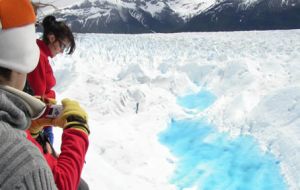MercoPress. South Atlantic News Agency
Argentina’s glacier continues to flourish in spite of global warming
 The spectacular Perito Moreno, a world tourist attraction in Patagonia.
The spectacular Perito Moreno, a world tourist attraction in Patagonia. Faced with daily headlines warning of the dire repercussions of global warming and the havoc in the planet’s polar regions, it may seem like something of an anomaly that Argentina's Perito Moreno glacier has continued to flourish in the face of such ostensible environmental calamity.
The 97 square mile icy monolith is the world’s third largest reserve of fresh water and one of 48 glaciers in Argentina and Chile fed by the melting snow that trickles down from the Andes.
Experts say that in the more than hundred years since scientists have been taking measurements, the Perito Moreno has managed to maintain a nearly perfect stability, with its terminus neither advancing nor receding appreciably. Growing at an astounding average speed of 6.6 feet per day, the glacier sheds a roughly equal amount of mass by dropping massive boulders of ice into a lake at its base.
“We're not sure why this happens,” said Andres Rivera, a glacier specialist at the Centre for Scientific Studies in Valdivia, Chile. “But not all glaciers respond equally to climate change.”
“Intermittently, the glacier reaches out across the large, L-shaped Lago Argentino (Argentine Lake) at its base to form a natural ice dam which divides the lake into two halves when it reaches the opposite shore. With a giant wall of ice separating the two sides of the lake and nowhere to drain the excess water flowing in, the water-level on the smaller side of the lake can rise almost 100 feet above the level of the main lake.
The unequal distribution of water creates a tremendous amount of pressure behind by the wall of ice, which eventually causes the ice dam to burst in a spectacular rupture event. Though occurring once every four to five years on average, the dam-rupture cycle have proven highly irregular and impossible to predict, occurring as often as once a year or as seldom as once a decade.
The first rupture event was observed in 1917 and demolished an ancient forest of arrayán trees in its wake. The last rupture was in July 2008, with 19 ruptures occurring in the more than 90 years between.
“It's like a massive building falling all of the sudden,” described park ranger Javier D'Angelo, who has witnessed the event twice in 2008 and 1998. The awe-inspiring rupture event is a visual symbol of the dynamic nature of this massive, 19-mile-long glacier system.
Thanks to its impressive size and relative accessibility, Perito Moreno has become the premier tourist hotspot in southern Patagonia. Less than two hours by bus from the small town of El Calafate in the Santa Cruz province, several tour companies now make daily trips to the glacier.




Top Comments
Disclaimer & comment rulesCommenting for this story is now closed.
If you have a Facebook account, become a fan and comment on our Facebook Page!